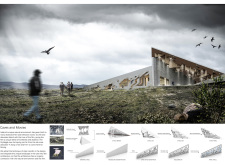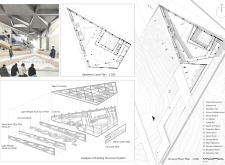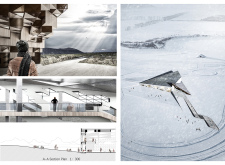5 key facts about this project
The design is set in Iceland, a country celebrated for its unique landscapes and rich cultural backdrop. The project aims to connect these natural features to the local cinematic identity, creating an environment that invites exploration and engagement. By using the concept of style transfer, the design takes cues from the Grjótagjá cave and traditional Icelandic turf houses, resulting in a structure that feels at home in its surroundings while reflecting themes found in Icelandic cinema.
Space Organization
The site is divided into three distinct areas, each shaped to respond to specific functional needs. This arrangement allows for a varied experience as visitors move through the space, highlighting important views of the mountains and volcanoes nearby. The design encourages movement, leading guests from one area to the next while fostering a sense of connection with the environment.
Visitor Experience
On arrival, visitors step into a large entrance that presents a feeling of openness. A gentle slope guides them to the main exhibition area, which features a "cavernous slot" on one side. This design element enhances the visual connection to the outside, framing views of the landscape. Walls are intentionally misaligned to create interesting sightlines, inviting people to engage with what lies beyond. Natural light filters through openings, casting changing patterns inside and adding to the overall atmosphere.
Exhibition Spaces
The building includes various interconnected areas focused on Icelandic cinema. Triangular exhibition halls provide insights into the history and future of cinema in the region, while an interactive hall presents opportunities for guests to experience classic movie scenes firsthand. A large atrium offers flexibility for temporary exhibitions and community gatherings, reinforcing the building's role as a cultural center.
Material Considerations
The structure employs lightweight aluminum plates, concrete blocks, and aluminum alloy grid structures, emphasizing both durability and simplicity. These materials work together to support the building's innovative form while blending with the natural environment. The choice of materials complements the overall aesthetic and supports the architectural story, enhancing the visitor experience and fostering a connection to the landscape.






















































